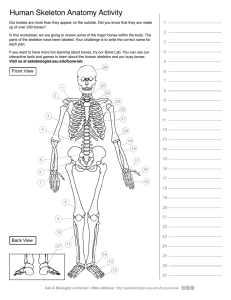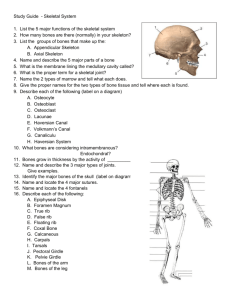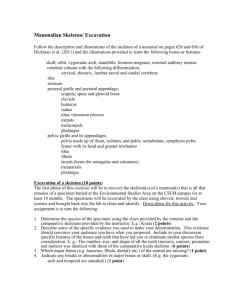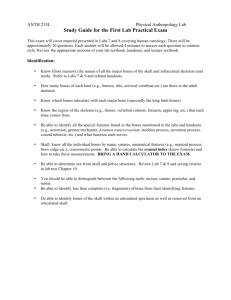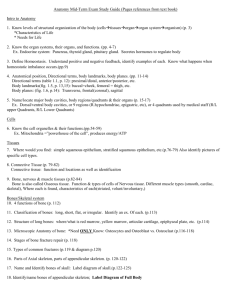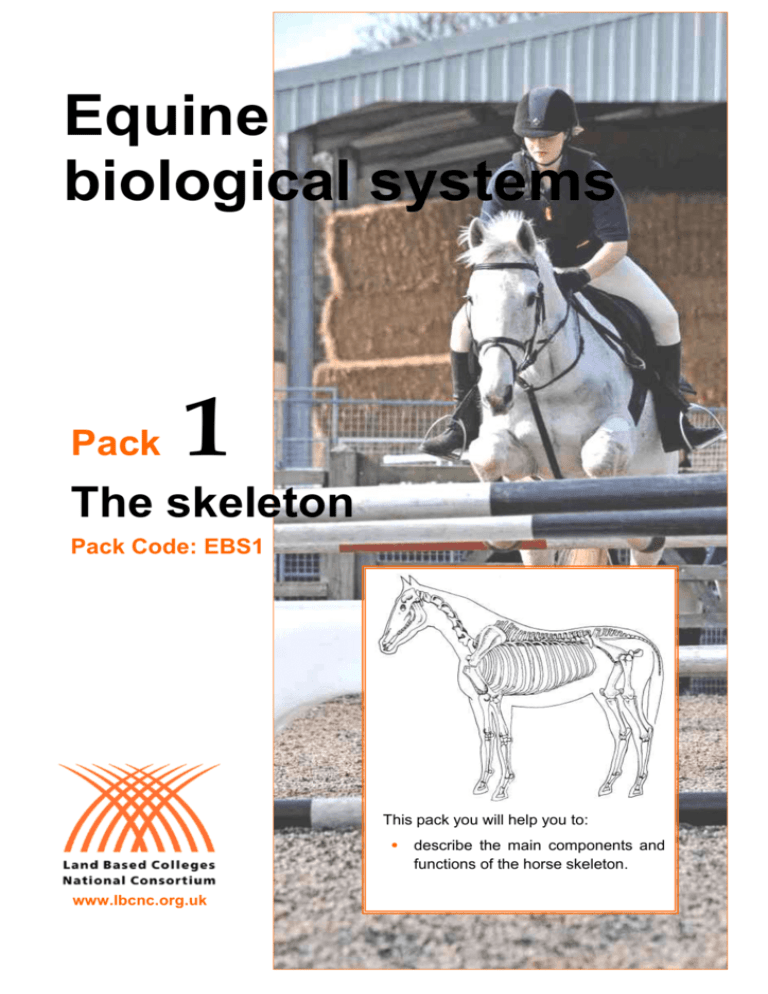
Equine
biological systems
Pack
1
The skeleton
Pack Code: EBS1
This pack you will help you to:
•
www.lbcnc.org.uk
describe the main components and
functions of the horse skeleton.
About this pack
Objectives
When you have completed this pack you should able to describe the main
components and functions of the horse skeleton.
The pack will help you to:
•
Identify the main bones of the horse skeleton and their functions.
The pack is also relevant to the level 3 unit Understand the Principles of
Animal Biology, and in particular to:
•
Outcome 3: Know the structure and function of animal skeletal systems.
It is also relevant to the level 3 unit on Understand Animal Anatomy and
Physiology, and in particular to:
•
Outcome 4: Understand how an animal’s body structure and systems are
adapted to its environment.
Links to other packs
This is one of a series of learning packs, each tackling an aspect of equine
biology. They are:
•
EBS1: The skeleton
•
EBS12: Muscle and nervous tissue
•
EBS2: Joints
•
•
EBS3: Circulation
EBS13: The horse’s sensory
organs
•
EBS4: Respiration
•
EBS14: Introduction to genetics
•
EBS5: The digestive system of the
horse
•
EBS15: Meiosis
•
EBS16: Inheritance
•
EBS6: The reproductive system
•
EBS17: Selective breeding
•
EBS7: Oestrus and hormones
•
EBS18: Breeding technology
•
EBS8: Gestation and birth
•
EBS19: Managing breeding
•
EBS9: How animal cells work
•
EBS20: The lymphatic system
•
EBS10: How animal cells divide
•
EBS21: The endocrine system
•
EBS11: Connective and epithelial
tissue
•
EBS22: The nervous system
Equine biological systems
2
Overview of the skeleton
This pack describes the general skeletal system for horses.
Functions of the skeleton
•
support soft tissue, and maintain the animal's body shape
•
protect the delicate organs e.g. the ribcage protects the heart and lungs
•
attach muscles and tendons
•
enable movement through joints, e.g. to move a limb forward
•
provide a site for forming blood cells (in the bone marrow)
•
store calcium and phosphate in bones until they are needed by the body.
Types of bones
Bones come in four basic shapes, each of which has particular roles to play.
Long bones:
for movement and strength – these include most of the
limb bones e.g. thigh bone
Short bones:
for limited movement and strength – cube shaped bones
e.g. carpals (wrist bones in humans)
Flat bones:
for protection – these include skull bones, shoulder blades
and pelvis
Irregular bones for muscle attachment – all the bones which are not long,
short or flat e.g. vertebrae, kneecap.
Review quiz 1
Are the following statements true or false?
True
False
a) Irregular bones protect delicate organs.
b) Long bones provide strength.
c) Short bones provide strength.
d) Flat bones function mainly as points for muscle attachment
Answers are given at the end of this pack.
Equine biological systems
3
Two parts of the skeleton
The skeleton includes all the bones of the animal. It is divided into two parts:
the central axial skeleton to which the appendicular skeleton is attached. The
following diagram shows the main bones we consider during the course of
this pack.
Activity
This activity will help you start to familiarise yourself with the bones of an
animal – which could be a pet. You may find it helpful work on it with
other students. You don't need to learn the names of the bones at this stage.
For an animal you work with:
•
identify the main bones shown on the word diagram on the animal
•
where possible feel the bones to get an idea of their location and shape.
The axial skeleton
The axial skeleton includes the skull, backbone, ribcage and tail.
Skull
The skull is the complex set of 37-38 bones in the head of the animal. Most of
the bones are connected by immovable joints. The only freely moveable joint
is that of the lower jaw (mandible). This diagram shows the skull of a horse.
Equine biological systems
4
Note that the skulls of different animals have different adaptations – while
the horse – a herbivore – does not have large canines and moves its jaws in a
circular way to grind food, predators have strong canine teeth and bite with
a slicing movement. Whales have evolved rather different skulls.
There are three main groups of skull bones:
1
Bones of the cranium – these bones surround and protect the brain.
Internal bones are not visible from the outside, whereas external bones
can be recognised on the animal.
2
Bones of the ear – these bones are all hidden.
3
Bones of the face. These bones give shape to the face. External bones of the
face include:
•
incisive bones which house the upper incisors
•
nasal bones which form the bridge of the nose. The length of the animal's
face is reflected in the length of these bones, which are long in the horse.
•
maxillary bones which make up the upper jaw (maxilla) and hard palate,
and house the upper teeth other than the incisors
•
the mandible (lower jaw) which houses the lower teeth.
Teeth
Different types of teeth and their functions are described in Pack 5 The
digestive system of the horse.
Backbone (vertebral column)
The main functions of the backbone are to:
•
Equine biological systems
provide support to the limbs
5
•
protect the spinal cord (by forming a channel called the 'vertebral canal')
The backbone is made up of a series of irregular shaped bones called
vertebrae which extend from the skull to the tail. It is divided into five
regions. This table compares the number of vertebrae in each region for
horses with other farm animals .
horse
cattle
goat
pig
sheep
Cervical:
neck region
7
7
7
7
7
Thoracic:
above the
chest
18
13
13
14-15
13
Lumbar:
above the
abdomen
6
6
7
6-7
6-7
Sacral:
above the
pelvis
5
5
5
4
4
Coccygeal:
the tail
15-21
18-20
16-18
20-23
16-18
Vertebrae do not have individual names, instead they are numbered within
each region from head to tail, so C7 is the seventh cervical vertebrae, and L2
the second lumbar vertebra.
In different animals there have been adaptations of this basic design. While
the giraffe has the same number of neck or cervical bones as other mammals
– seven – the bones have become much larger as the giraffe’s neck has grown
longer. There are different explanations for this – some people argue that the
giraffe’s neck is for reaching high branches, others that they are used for
fighting.
Vertebrae
Equine biological systems
6
A typical vertebra has a body, an arch and a group of processes
(protrusions). Protrusions act as sites for muscle attachment and help form
joints between adjacent vertebrae. When the holes in the vertebrae are lined
up they form the spinal canal which houses and protects the spinal cord.
Intervertebral discs lie between the vertebrae and help to absorb shock.
The vertebrae throughout the backbone are fairly similar, with the following
exceptions:
•
the atlas (the first cervical vertebra) is a simple ring of bone with two
processes which allows for nodding movement of the head
•
the axis (the second cervical vertebrae) has a process which fits into the
axis, allowing for side to side movement of the head.
•
the sacral vertebrae are fused to form the sacrum – a single structure
joined to the pelvis.
Chest (thoracic cage)
The bones of the chest include vertebrae and:
•
The breastbone (sternum) which forms the front of the thorax.
•
The ribs – most horses have 36 ribs, though some breeds have 37 or 38.
Joints between the vertebrae and ribs, and cartilage between the ribs and
the breastbone allow the ribcage to expand and contract as the animal
breathes.
Equine biological systems
7
Review quiz 2
1
Match the following regions with vertebrae
2
Neck:
coccygeal
Chest:
sacral
Abdomen:
cervical vertebrae
Pelvis:
lumbar
Tail:
thoracic
Match the following common and technical names for bones in the axial
skeleton:
3
upper jaw
maxilla
lower jaw
sternum
breastbone
mandible
Are the following statements true or false?
True
False
a) teeth are housed in the cranium
b) the lower jaw is the only bone which moves in the head
c) the ribs are fixed rigidly to the spine
d) the axis allows for side to side movement of the head
Answers are given at the end of this pack.
Aquatic mammals
The skeletons of whales and dolphins have evolved to become rather
different from other mammals. The backbone is long – a dolphin has 73
vertebrae – though the vertebrae do not extend into the tail which is made
up of cartilage. Whale bones are spongier than other mammals as the
animals are supported by water.
The forelimbs have become flippers – though
interestingly the bones are remarkably similar to
those in humans. However there are no external
hind limbs.
Equine biological systems
8
The appendicular skeleton
The appendicular skeleton includes the bones of the fore and hind limbs.
Forelimb
The forelimb includes the bones from the shoulder blade down through the
limb to the phalanges. Unlike humans there is no collar bone to link the
forelimb to the backbone, instead the attachment is achieved through
muscles and tendons.
This diagram shows the forelimb of a horse. The bones are:
• Scapula (shoulder blade) – this
includes the socket part of the
shoulder joint.
• Humerus – this is the long bone of the upper arm, and includes the
ball part of the shoulder joint.
• Radius – the main weight-bearing bone of the forearm, which works
with the ulna.
• Ulna – the humerus and ulna lie parallel to each other and meet at the
elbow joint.
• Carpals – this is two rows of bones, which is called the knee in horses.
In humans they form the wrist.
• Metacarpals – in humans these bones form the palm of the hand.
Horses have only one carpal bone.
• Phalanges – in humans the five fingers (or digits) each have three
phalanges. Horses have one digit with three phalanges.
Different animal species have again evolved different arrangements of the
forelimb. In digging animals like moles the arms are stout, the hands are
broad and claws are strong.
In bats the forelimb has evolved into
a wing. The finger bones are much
longer than in many mammals, and
are more flexible.
Hindlimb
The hindlimb is directly connected to the backbone through the pelvis. This
avoids the need for a sling of muscles and tendons used to connect the
forelimb to the backbone, thus leaving room in the abdominal cavity for the
reproductive, digestive and urinary structures.
Equine biological systems
9
This diagram shows the hind limb of a horse. The bones are:
•
Pelvis (not shown here – see skeleton diagram at end of pack) – the
pelvis is a girdle attached to the backbone at the sacroiliac joint. It
provides the socket for the hip joint. The newborn animal must pass
through the space in the middle of the female pelvic girdle at birth.
•
Femur (thigh bone) – the top end of this long bone forms the ball
part of the ball and socket hip joint. The lower end forms the stifle
joint with the patella and tibia.
•
Patella (kneecap) – the kneecap is the largest irregular (sesmoid)
bone in the body, and forms the front of the stifle joint where it
protects the tendon.
•
Tibia (shinbone) – this is the main weight bearing bone in the lower
leg. It meets the femur in the stifle joint.
Note that in some animals such as dogs and cats there is a thin bone
parallel to the tibia called the fibula. In cattle only the ends of the
bone are present. It serves as a muscle attachment site.
•
Tarsals ('hock' in horses; ankle in humans) – the hock comprises two
rows of short bones similar to the carpal bones in the forelimb. The
calcaneal tuberosity projects up and back forming the point of the
hock, and is equivalent to our heel. It is the attachment point for the
calf muscle.
•
Metatarsals - similar to the metacarpals of the forelimb. In humans
these form the sole of the foot.
•
Phalanges - as for the forelimb.
Activity
Once again, the skeletal design of different animals varies to reflect how
they move. The diagrams here show the hind legs, from left to right, of the
horse, sheep and dog. What differences do you notice between them?
Equine biological systems
10
The horse has no muscles below the knee and so the lower leg is held
together by a group of tendons (which attach muscle to bone) and ligaments
(which attach bone to bone usually forming a joint). There is much strain on
the ligaments especially when the horse is in gallop and if too much pressure
is applied the ligaments (normally the suspensory ligament) can give way –
this is sometimes irreparable.
Activity
Label the parts of the horse skeleton using the following terms:
cervical vertebrae, carpals, coccygeal, femur, humerus, lumbar vertebrae,
metacarpals, metatarsals, pelvis, phalanges, radius, ribs, sacrum,
scapula, skull, sternum, tarsual, thoracic vertebrae, tibia.
Distinguish (with colour or other means) the bones of the axial and
appendicular skeletons.
Check your answers with the word skeleton at the beginning of this pack.
Find a diagram of a skeleton of a different animal – for example, a sheep,
dog or rabbit – and note down differences between them. What might
explain these differences?
Equine biological systems
11
Answers to review quizzes
Review quiz 1
a) False
b) True
c) True
d) False
Review quiz 2
1 Neck:
cervical vertebrae
Chest:
thoracic
Abdomen:
lumbar
Pelvis:
sacral
Tail:
coccygeal
2 upper jaw
maxilla
lower jaw
mandible
breastbone
sternum
3 a) False b) True c) False d) True
Answers to activity on page 4
You may have noticed that skeletal design differs in different animals. For
example, in many animals the metacarpals/metatarsals and phalanges are
much more extended than the equivalent hands and feet in humans.
Don't worry if you found the names of bones confusing, or they were
difficult to identify - the rest of this pack goes on to look at the skeleton in
more detail.
Further reading
Zoe Davies, Introduction to horse biology, Wiley Blackwell, 2005 which
contains a chapter on the skeleton
Sarah Pilliner and Zoe Davies, Equine science, Wiley Blackwell, 2004 which
also contains a chapter on the skeleton
D.R. Lane and B Cooper, Veterinary Nursing (3rd edition). Butterworth
Heinemann, 2003
Useful websites include:
http://www.earthlife.net/mammals/skeleton.html
Equine biological systems
12
Knowledge quiz
Check your knowledge with the following questions.
1
List four functions of the skeletal system.
2
List the four main types of bones, and give the main function of each.
3
List the main bones in the axial skeleton.
4
List the main bones in the forelimb, from the top downwards.
5
List the main bones in the hindlimb from the top downwards.
6
What are the two main functions of the backbone?
7
The fore limb is attached to the backbone through:
the shoulder joint
muscles and tendons
the scapula
8
The hind limb is attached to the axial skeleton through:
the sacroiliac joints
the hip joint
muscles and tendons
Equine biological systems
13
Glossary
Appendicular skeleton
limb girdles and limbs
Articulation
movement
Atlas
first bone of the backbone (C1) - allows for
nodding of the head
Axial skeleton
skull, backbone breastbone and ribcage
Axis
second bone of the backbone (C2) - allows
for side to side movement of the head
Calcaneal tuberosity
point at the back of the hock (ankle) equivalent to the human heel
Carpals
wrist
Cervical
neck region
Cranium
upper part of skull
Femur
thighbone
Humerus
upper forelimb bone
Lumbar
small of back
Mandible
lower jaw
Maxilla
upper jaw
Metacarpals
hand (excluding fingers) in humans
Metatarsals
foot (excluding toes) in humans
Patella
kneecap
Phalanges
fingers/toes in humans
Radius
lower forelimb bone
Sacroiliac joint
where the hindlimb and pelvis meet
Sacral
lower back
Scapula
shoulder blade
Tarsals
ankle (hock)
Tibia
shin bone
Thoracic
chest
Vertebrae
bones which make up the backbone
Equine biological systems
14
Acknowledgements
This learning pack has been produced by the Land Based Colleges National Consortium
Ltd.
The LBCNC is a consortium of colleges working in the land-based sector which cooperate in the development and production of quality flexible learning materials
which encourage independent learning.
We would like to acknowledge the contributions made by the following individuals
and colleges in the development of this learning pack.
Additional material for revised edition
Debbie Smith, Bridgwater College
Cover photograph: Steve Watson, Riseholme College, University of Lincoln
Developed and produced for LBCNC by Learners First
Written by May Johnstone
Illustrations: Shevanthi De-Silva
Revised in July 2011
© 2011 The Land Based Colleges National Consortium Ltd. All rights reserved.
Permission to photocopy or adapt the material in this learning pack is granted to
members of the Land Based Colleges National Consortium Ltd. only.
For further information please contact the LBCNC project management team at 7
Tyne Road, Bishopston, Bristol BS7 8EE.
Tel 0117 942 3504
Equine biological systems
15


